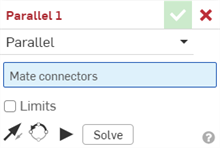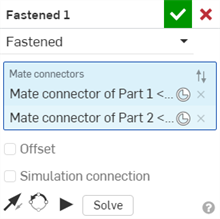 Parallel Mate
Parallel Mate
![]()
![]()
![]()
Mate two entities allowing individual translational movement along any axis, and parallel rotation along any axis.
The Planar mate has 3 degrees of freedom, allowing translation in the X and Y axes and rotation about the Z axis. Start a new Planar mate. Select a point on each instance where they should touch. The instances move so that the mate connectors align, but they are not restricted to this location with respect to their degrees of freedom.
The Planar mate is often paired with other mates when defining more complex assembly movements. For example, a Planar mate pairs with a Tangent mate to keep a pin in a curved slot.
The Ball mate has 3 degrees of freedom, allowing rotation about the X, Y, and Z axes. Start a new Ball mate. Select a mate connector in the center of the socket and a mate connector in the center of the ball. The mate moves like a ball-and-socket joint.
The Parallel mate has 4 degrees of freedom, allowing translation in the X, Y, and Z axes, and rotation about the Z axis.
Start a new Parallel mate. In this example, the bottom of a large magnet controlled by a robot arm should stay parallel to the base. Select a mate connector on the two faces that should stay parallel to each other. The instances move so that the mate connectors are touching, but they are not restricted to this location with respect to their degrees of freedom.
Steps
-
Click
 .
.
- Select two Mate connectors (implicit or explicit).

- To impose limits on the movement of the Mate, click Limits and supply minimum and maximum distances for the relative displacement of the Mate connectors.
Limits are visualized in the graphics area as dashed lines with bars at the ends. The dashed lines represent the direction and distance of the movement and the solid lines represent the limit.
If a Mate has one or more applied limits, the Mate limit indicator icon
 is visible to the right of the Mate in the Mate Features list.
is visible to the right of the Mate in the Mate Features list. - Click the entity to access the manipulator.
- Click and drag the various manipulator handles to see which motions are allowed; notice that the parallel Mate allows the entities to translate freely in the X, Y, and Z directions and that the entities are able to rotate freely around the Z axis while the Mate keeps the Mate connectors parallel.
Editing a Mate connector
Once a Mate is created between two explicit or implicit Mate connectors, you can edit either Mate connector:
-
Open the Mate dialog. In the example below, the Fastened mate is used as an example. The process is similar for all Mates, except Tangent mate which does not use Mate connectors.

-
Click the Mate connector icon (
 ). The Mate connector dialog opens, where you can edit the mate connector's origin type, origin entity, alignment, location, primary axis direction, and secondary axis orientation:
). The Mate connector dialog opens, where you can edit the mate connector's origin type, origin entity, alignment, location, primary axis direction, and secondary axis orientation:

Editing Mate connectors from the Mate dialog is limited to implicit or explicit connectors located in the current Assembly. Mate connectors from Part Studios, subassemblies, or linked documents must be edited in their original location.
Steps
-
Tap the Parallel mate icon (
 ).
).

- Confirm that Parallel is selected in the Mate type field.
- Select two Mate connectors (implicit or explicit) to use.
- Optionally, tap Limits to set distance limits for movement.
-
Optionally, tap
 to Flip the primary axis, Z orientation of the instances.
to Flip the primary axis, Z orientation of the instances.
-
Optionally, tap
 to Reorient the secondary axis; rotate the quadrant orientation (in the XY plane) of the instances by 90 degrees at a tap.
to Reorient the secondary axis; rotate the quadrant orientation (in the XY plane) of the instances by 90 degrees at a tap.
- Tap checkmark.
Touch and drag OR use the Triad Manipulator to move one of the parts. Notice that the parallel Mate allows the parts to translate freely in the X, Y, and Z directions and that the parts can rotate freely around the Z axis while the Mate keeps the Mate connectors parallel.


Steps
-
Tap
 .
.
- Confirm that Parallel is selected in the Mate type field.
- Select two Mate connectors (implicit or explicit) to use.
- Optionally, tap Limits to set distance limits for movement.
-
Optionally, tap
 to Flip the primary axis, Z orientation of the instances.
to Flip the primary axis, Z orientation of the instances.
-
Optionally, tap
 to Reorient the secondary axis; rotate the quadrant orientation (in the XY plane) of the instances by 90 degrees at a tap.
to Reorient the secondary axis; rotate the quadrant orientation (in the XY plane) of the instances by 90 degrees at a tap.
- Tap checkmark.
Touch and drag OR use the Triad manipulator to move one of the parts. Notice that the parallel mate allows the parts to translate freely in the X, Y, and Z directions and that the parts are able to rotate freely around the Z axis while the Mate keeps the Mate connectors parallel.

